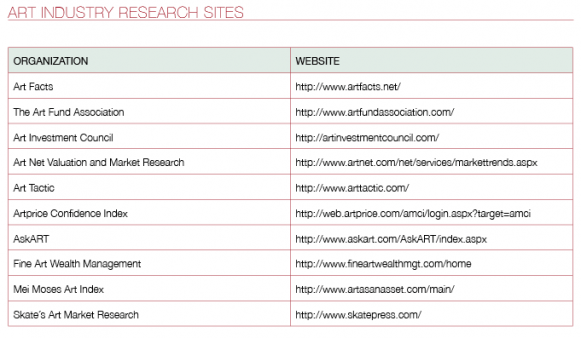

Understanding the Underlying Asset, Understanding Art:
According to the Art & Finance Report by Deloitte & Art Tactic, confidence in the Art Fund Industry is mixed. “The majority of art professionals and collectors believe the art fund industry will expand in the next 2-3 years, but wealth managers are still very cautious.” Issues such as “Due Diligence Process for the Experienced Investor,” “Liquidity in the Art Market,” “Asset Pricing: Art,” “Track Record for Art Funds,” and “Unregulated Market” are listed among top concerns of wealth managers and have kept the industry in the boutique investment sector.
This series of myth-busters will address the five issues and concerns mentioned above plus some more we believe are relevant: “Identifying the Risks”, “Sourcing the Right Experts,” “Arm’s-Length Transactions and Other Possible Conflicts of Interest,” and “Fiduciary Duty”.
Along with the financial considerations, we will also publish the philosophical and intellectual counterpart in nine parallel articles. This part will deal with decoding the financial assertions into artistic terms. “Due Diligence Process for the Trained Eye,”“The Permanence of Art,”“The Aesthetic Experience as an Artistic Assesment,”“Art Throughout History,” “Art in Transit,” “Rediscovering the Value and Risk of Art,”“Exposing the Taste Makers,” “Conflicts of Interest: Chronicles of an Artwork,” and “The Universal Language of Art”.
Our aim is to portray the possibilities of art-investment funds as institutionalized art-investment vehicles. Funds are an efficient, reliable and transparent one-stop-shop that benefit from economies of scale, portfolio optimization and the inefficient and unregulated art market. Investment funds like AGF have managed to securitize art efficiently through strict but practical operating mechanisms.
It is our intention to promote transparency, credibility and efficiency in the art investment industry across our proven experience and we have the record to show it.
10. Co-Investments
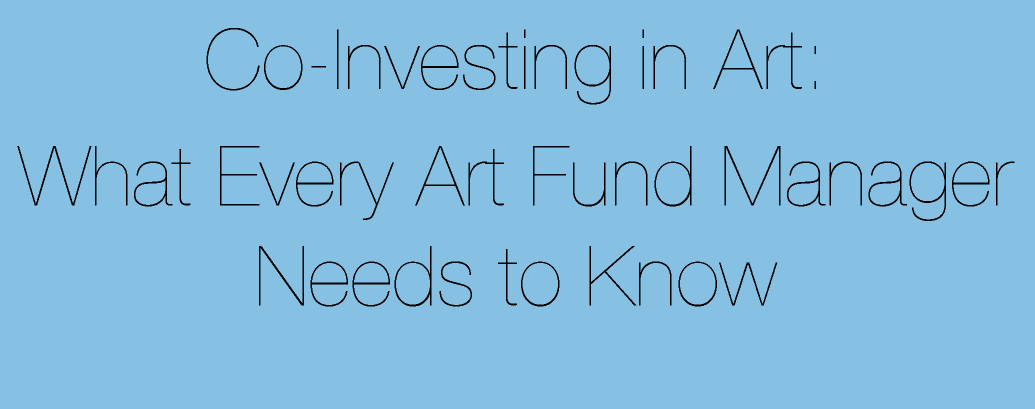 Art investment funds have long embraced the use of co-investments in artworks as a principal investment strategy. While the benefits of art co-investments clearly merit their use by art funds, art co-ownership arrangements do involve significant risks to the implementation of a fund’s investment program that if not properly addressed can frustrate the fund manager’s intentions regarding the ownership of, and anticipated benefits from, the co-owned artwork. More…
Art investment funds have long embraced the use of co-investments in artworks as a principal investment strategy. While the benefits of art co-investments clearly merit their use by art funds, art co-ownership arrangements do involve significant risks to the implementation of a fund’s investment program that if not properly addressed can frustrate the fund manager’s intentions regarding the ownership of, and anticipated benefits from, the co-owned artwork. More…

Artists aren’t exactly known for their accommodating, easy-going ways. More often, words such as “egocentric” and “introverted” spring to mind when thinking of an artist. In reality, though, few artists work in total isolation, especially once they have achieved a certain level of success. This document explores artistic collaborations and the issues of authorship and validation in the joint production of art. More…
9. Fiduciary Duty
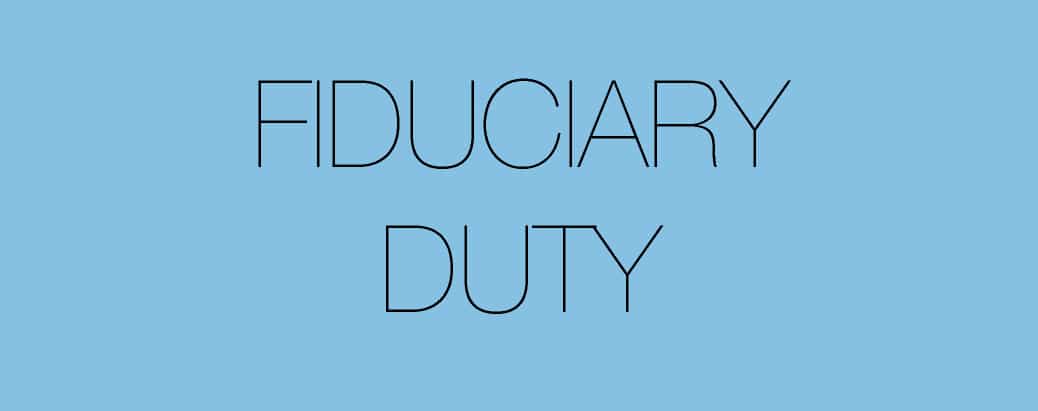 Deloitte’s biggest concern about fiduciary duty in the art market lies specifically in the responsibilities of art advisors: “An art market downturn is likely to raise questions on the legally vague fiduciary responsibilities of new intermediaries, such as art advisors.”But what is “fiduciary duty” and which advisors are they specifically referring to? Since the times of Roman Law, a creditor in “fiducia” was obligated to keep the property under his possession in safekeeping to the benefit of the debtor and reconvey the same except in case of default. More…
Deloitte’s biggest concern about fiduciary duty in the art market lies specifically in the responsibilities of art advisors: “An art market downturn is likely to raise questions on the legally vague fiduciary responsibilities of new intermediaries, such as art advisors.”But what is “fiduciary duty” and which advisors are they specifically referring to? Since the times of Roman Law, a creditor in “fiducia” was obligated to keep the property under his possession in safekeeping to the benefit of the debtor and reconvey the same except in case of default. More…
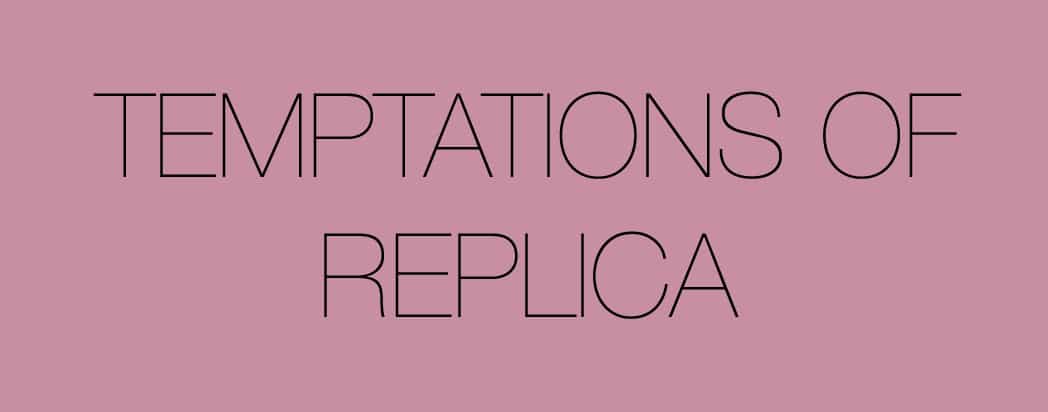 Given that the business-minded counterpart to this text illustrates the legally binding fiduciary responsibilities on the art market’s transactional advisors, this academic-oriented document will analyze what could be an intrinsic “fiduciary duty” that relies in the artist himself. To explain, when an artist gains international recognition, translated into demand for his work, his artistic integrity might be compromised. Maintaining his currently celebrated style could limit his creative evolution. More…
Given that the business-minded counterpart to this text illustrates the legally binding fiduciary responsibilities on the art market’s transactional advisors, this academic-oriented document will analyze what could be an intrinsic “fiduciary duty” that relies in the artist himself. To explain, when an artist gains international recognition, translated into demand for his work, his artistic integrity might be compromised. Maintaining his currently celebrated style could limit his creative evolution. More…
8. Arm’s-length Transaction
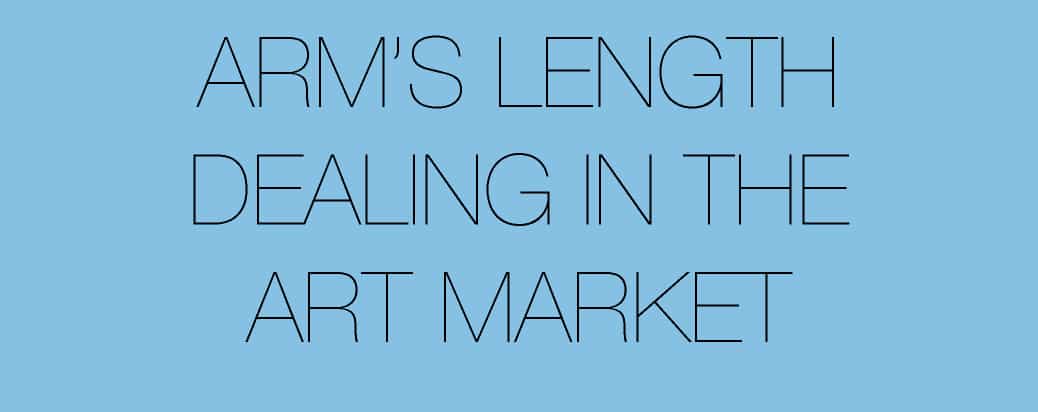 One of the common criticisms made against art as a formal investment asset class, mostly by mainstream business and financial consultants, is that the art market seems to be more prone to conflicts of interest than others. A “conflict of interest” is a “a situation where a professional, or a corporation, has a vested interest which may make them an unreliable source. More…
One of the common criticisms made against art as a formal investment asset class, mostly by mainstream business and financial consultants, is that the art market seems to be more prone to conflicts of interest than others. A “conflict of interest” is a “a situation where a professional, or a corporation, has a vested interest which may make them an unreliable source. More…
 What might Picasso’s Young Ladies of Avignon have in common with Rembrandt’s Night Watch? Perhaps, for the untrained eye, there is no similarity between them. They do not have the same style, nor do they have the same theme. Perhaps the most obvious observation could be that they belong to very different historical periods and artistic movements. Nevertheless, there is no doubt that both of them represent, in their own way, iconic artworks that never fail to amaze every generation, i.e., they are both “masterpieces.” More…
What might Picasso’s Young Ladies of Avignon have in common with Rembrandt’s Night Watch? Perhaps, for the untrained eye, there is no similarity between them. They do not have the same style, nor do they have the same theme. Perhaps the most obvious observation could be that they belong to very different historical periods and artistic movements. Nevertheless, there is no doubt that both of them represent, in their own way, iconic artworks that never fail to amaze every generation, i.e., they are both “masterpieces.” More…
7. Sourcing the Right Experts
 There are numerous complications that arise in the process of managing fine art. Without the right expertise, the day-to-day management of a diversified art portfolio can likely face numerous risks related to art investing. Just as investors will involve lawyers and advisers to carry out a due diligence previously to performing significant investments, there is a necessity of similar rigour in art management. More…
There are numerous complications that arise in the process of managing fine art. Without the right expertise, the day-to-day management of a diversified art portfolio can likely face numerous risks related to art investing. Just as investors will involve lawyers and advisers to carry out a due diligence previously to performing significant investments, there is a necessity of similar rigour in art management. More…
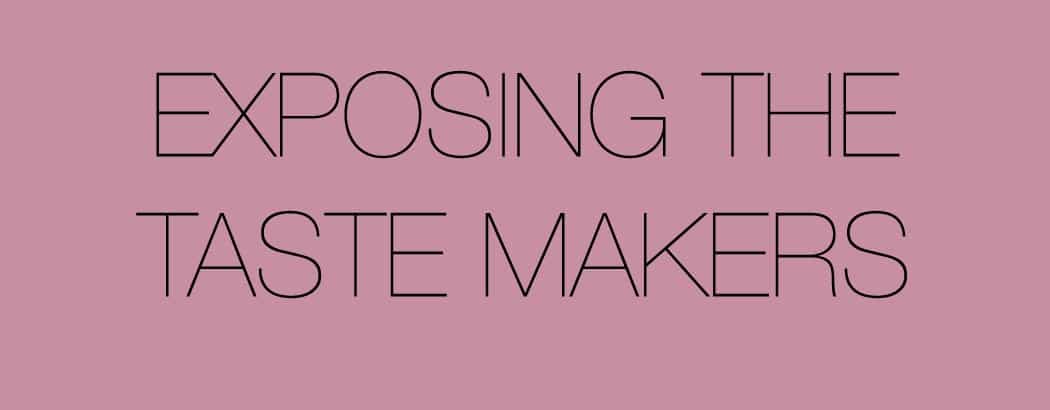 Although different kinds of players in the art world including artists, professional intermediaries and even amateur collectors are agents of change, constantly transforming and challenging new proposals, there has always been the concept of taste, understood as an aesthetic standard of reference, that separates inclusion from exclusion. More…
Although different kinds of players in the art world including artists, professional intermediaries and even amateur collectors are agents of change, constantly transforming and challenging new proposals, there has always been the concept of taste, understood as an aesthetic standard of reference, that separates inclusion from exclusion. More…
6. Identifying Risks
 According to the last Art & Finance Report by Deloitte & Art Tactic, confidence in the Art Fund Industry is mixed. The report states: “The majority of art professionals and collectors believe the art fund industry will expand in the next 2-3 years, but wealth managers are still very cautious. Risks such as “Authenticity,” “Title,” “Investment,” “Casualty,” “Currency” and “Macroeconomic Risk or Uncertainty” are listed among top concerns of wealth managers and have kept the industry in the boutique investment sector. More…
According to the last Art & Finance Report by Deloitte & Art Tactic, confidence in the Art Fund Industry is mixed. The report states: “The majority of art professionals and collectors believe the art fund industry will expand in the next 2-3 years, but wealth managers are still very cautious. Risks such as “Authenticity,” “Title,” “Investment,” “Casualty,” “Currency” and “Macroeconomic Risk or Uncertainty” are listed among top concerns of wealth managers and have kept the industry in the boutique investment sector. More…
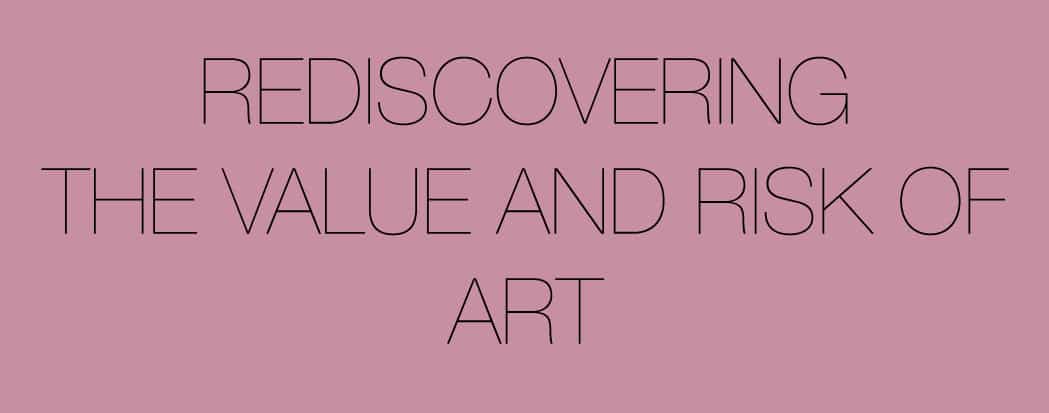
The counterpart to this article addresses -from the business perspective- the risks of investing in art and some of the specific measures that Artemundi Management Limited, as a professional art investment manager, has taken to reduce the same in the present day art market. More…
5. Unregulated Market
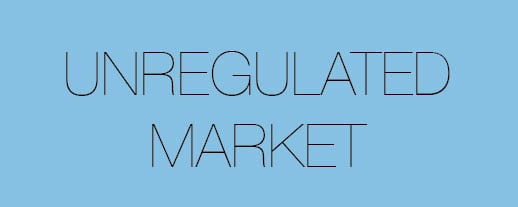
The art market is one of the very few unregulated markets left in the global economy. Despite the lack of regulations, it is one of the oldest and more established trades in the world, and is characterized by very old principles and conventions. Its structure and power circles had not changed much in two hundred years until the last decade saw the advent of technology that transformed the role of each player. More…
 Is art a risky asset? May one of the reasons behind such thinking include that it is normal for this particular type of asset to “travel” internationally from one place to another? Or, on the other hand, is investing in art risky because this kind of property may be restricted in mobility if the state exercises certain legal prerogatives over it? It has been argued before that one of art’s disadvantages as an investment is the lack of market regulations. More…
Is art a risky asset? May one of the reasons behind such thinking include that it is normal for this particular type of asset to “travel” internationally from one place to another? Or, on the other hand, is investing in art risky because this kind of property may be restricted in mobility if the state exercises certain legal prerogatives over it? It has been argued before that one of art’s disadvantages as an investment is the lack of market regulations. More…
4. Lack of Track Record
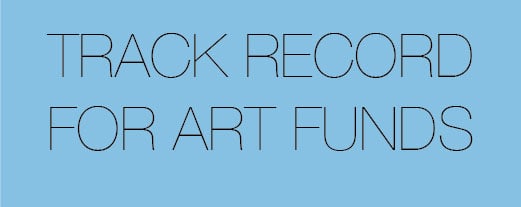
It is commonly said that to understand one’s present one must understand one’s history. Moreover, it is difficult to forecast the future without understanding the past and the present. Financial instruments are not immune to this premise, their development and execution depends a great deal on historic or past outcomes and facts. More…
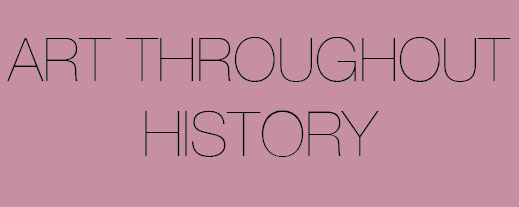
There are various methods to explain the development of a people or a society. One of these methods consists in analyzing art as a historical trace or memory. The tool to achieve this goal is Art History. More…
3. Valuation
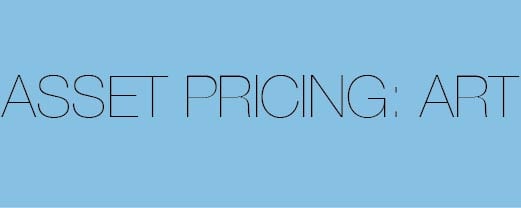
Asset pricing has become one of the main pillars of modern financial theory and everyday financial use. Mainly because knowing the correct price of an asset is the only way to measure and therefore estimate risk and return degrees. Moreover, these measurements are indispensable when securitizing assets into financial instruments. Art as an asset does not escape from this premise; art cannot be considered an investable asset if it is not properly valuated. However, despite what many investors fear every artwork can be accurately priced. More…
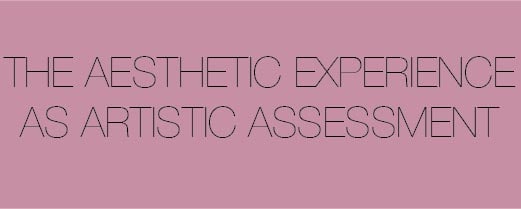
How do we valuate a work of art? To determine its price, what criteria do we have to take into consideration? Which factor makes one object cost a fortune while a similar other costs only a few cents? Why is it that two artists belonging to the same art style have almost identical aesthetic techniques, yet such dissimilar prices? More…
2. Liquidity
 The first concern of any investor when allocating capital in art is its illiquidity compared to most of traditional financial vehicles. However art’s qualities as an investable asset overcome any illiquidity matters because of overall long-term benefits in an investment portfolio. More…
The first concern of any investor when allocating capital in art is its illiquidity compared to most of traditional financial vehicles. However art’s qualities as an investable asset overcome any illiquidity matters because of overall long-term benefits in an investment portfolio. More…
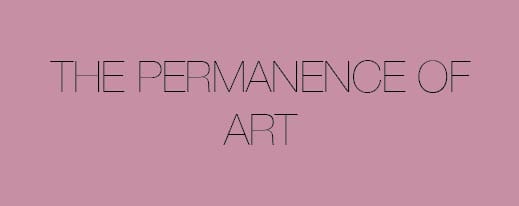
What role does art criticism play in the institutional world of art? Is the value of an artwork mainly determined by its quality and permanence, or is it influenced by the critics’ opinion as well? More…
1. Due Diligence
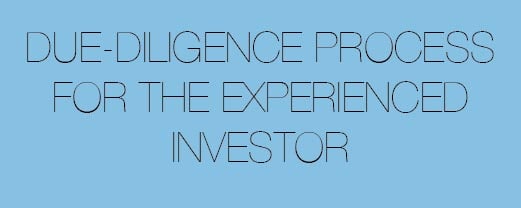
Before investing in Art, a thorough due diligence must be performed in order to guarantee the viability of the investment. It is never really possible to guarantee that an investment will be profitable; however, the probabilities rise exponentially if the correct artwork is selected. More…
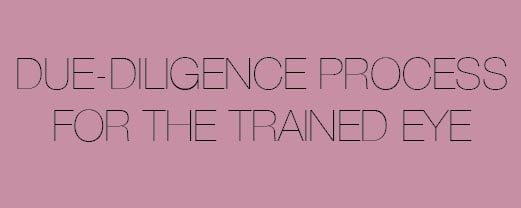 Consider this: Why do people put up with long lines and hours standing outside the door of museums doors in order to see an exhibition or even a single canvas? Why do all major cities that regard themselves as such spend enormous sums on building big museums? Why do philosophers untiringly debate the nature of art? Does art perhaps serve us as therapy in developing a mental gymnastics? More…
Consider this: Why do people put up with long lines and hours standing outside the door of museums doors in order to see an exhibition or even a single canvas? Why do all major cities that regard themselves as such spend enormous sums on building big museums? Why do philosophers untiringly debate the nature of art? Does art perhaps serve us as therapy in developing a mental gymnastics? More…
- 10-26-2012 For whom the bell tolls: the death of Christie’s and Sotheby’s
- 03-05-2013 What is the true reason behind Christie’s and Sotheby’s increase in buyer’s premiums?
- 11-20-2013 A Triptych from Francis Bacon (British 1909-92) sold for 142 million. Really? Why?
- 01-31-2014 Is an artwork “Burnt” by failing to sell at a public auction?
- 10-01-2014 Interview with Javier Lumbreras: The Current State of the Art Fund Industry
- 08-26-2015 The impossibility of a two digit drop (in as many) in the art market
- 10-08-2015 If the Market were More Transparent, these Things wouldn’t happen
- 10-14-2015 Has the Art Market Entered a Bubble?
- 11-05-2015 Auction Guarantees: All Animals are equal, but some are more equal than others
- 11-02-2015 Party-driven Art Fairs and Ego in the Art Market
- 12-16-2015 Why great art bores you: The new collector profile
- 01-07-2016 Does the world needs to rise up against curators?
- 01-21-2016 The Resilience of Art as an Investment
- 01-27-2016 Marie-Thérèse Walter: Still Famous for the Worng Reasons, Last week of exhibition, Must see
- 02-25-2016 Is the Masterpiece Market’s Appetite getting Smaller?
- 05-04-2016 A Prayer To Stop Sotheby’s Agony
- 04-21-2016 How to Kill the Art Market: A Cultural Inquest Regarding Export Control Law
- 03-05-2016 Don’t Believe Everything You Hear… Real Eyes Realize Real Lies
ERRATUM.
— In Does the Art World Need to Rise up Against Curators?, which we gave earlier today (01-07-2016), the line, “Josh Elderfield, curator at the Museum of Modern Art is now a consultant to Gagosian.” &c., ought to have been published, “John Elderfield, curator at the Museum of Modern Art is now a consultant to Gagosian.” &c. Artemundi welcomes comments and suggestions, or complaints about errors that warrant correction. Comments on editorials may be e-mailed to info@artemundi.com
& MORE…
In order to operate with more caution Artemundi Global Fund is continuously interested in analyzing the art market with our own means. Here are some free downloadable reports useful to anyone interested in the art market.
LONDON, MODERN & IMPRESSIONIST ART- February 2016
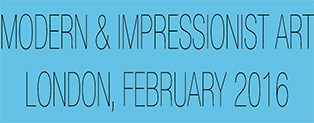 The London auction season opened with a low-key yet reassuring result, as Christie’s “Impressionist and Modern Art” evening sale delivered £66,430,000. Small-scaled works seemed to be the flavor of the evening as Alberto Giacometti’s 11-inch high bronze Femme debout, from a posthumous 1976 cast, made £1,082,500, and the 16 by 13-inch Fernand Léger oil on canvas Le moteur, a mini tour-de-force from 1918, snared £5,234,500.
The London auction season opened with a low-key yet reassuring result, as Christie’s “Impressionist and Modern Art” evening sale delivered £66,430,000. Small-scaled works seemed to be the flavor of the evening as Alberto Giacometti’s 11-inch high bronze Femme debout, from a posthumous 1976 cast, made £1,082,500, and the 16 by 13-inch Fernand Léger oil on canvas Le moteur, a mini tour-de-force from 1918, snared £5,234,500.
LONDON, POST-WAR & CONTEMPORARY ART- February 2016
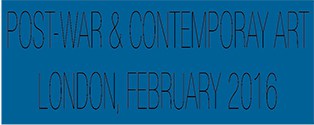
The Contemporary art evening sale at Sotheby’s auction house realised a final total of £69,461,000 with a BI of 27% from the 59 artworks offered. The sale was led by Lucian Freud’s tender portrait of his lover Bernadine Coverley, pregnant at the time with their daughter Bella. The 1960-61 work was pursued by six bidders and sold for £16.1 million, more than £9 million above the pre-sale low estimate and a new record for an early painting by the artist.
NEW YORK, POST-WAR & CONTEMPORARY ART- November 2015
 The Contemporary Art Day Auction at Sotheby’s totaled $98,025,250 with 80% of lots sold. The sale was led by Roy Lichtenstein’s Modern Painting with Yellow Interweave from 1967 which sold for $3.4 million, and Heat by Kenneth Noland, which set a new record for the artist at auction selling for $3.3 million. A Cy Twombly blackboard painting, Untitled (New York City), was the top lot in the Contemporary Art Evening Auction selling for $70.5 million, and is also the most expensive work sold at Sotheby’s worldwide in 2015.
The Contemporary Art Day Auction at Sotheby’s totaled $98,025,250 with 80% of lots sold. The sale was led by Roy Lichtenstein’s Modern Painting with Yellow Interweave from 1967 which sold for $3.4 million, and Heat by Kenneth Noland, which set a new record for the artist at auction selling for $3.3 million. A Cy Twombly blackboard painting, Untitled (New York City), was the top lot in the Contemporary Art Evening Auction selling for $70.5 million, and is also the most expensive work sold at Sotheby’s worldwide in 2015.
NEW YORK, IMPRESSIONIST & MODERN ART – November 2015

Sotheby’s Impressionist & Modern Art Day Sale on November 6th, 2015 featured a broad array of pictures, works on paper and sculpture by the leading artists of the late nineteenth and early twentieth centuries. Highlights included an oil portrait of a bather by Paul Cézanne which was once owned by Paul Signac, a 1906 Fauve picture by Raoul Dufy from a distinguished Asian collection, a monumental port scene by André Lhote from a private collection in Scandinavia, and an extremely rare and widely published oil by Heinrich Campendonk from the collection of Jules and Gladys Reiner.
NEW YORK, A. TAUBMAN COLLECTION: MASTERWORKS – November 2015
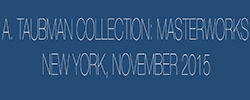
Alfred Taubman’s estate auction launched unsuccessfully last night. The eclectic collection once belonged to the magnate who resigned from his chairman’s role in 2000 amid a price-fixing scandal between Christie’s and Sotheby’s. . This precedent affected significantly the perceived value of the auctioned artworks, despite the fact that twelve pages of the catalogue tried to “clean” the moral character of the collectionist.
LONDON, POST-WAR & CONTEMPORARY ART – October 2015

The total amount sold in Post-War and Contemporary Auctions including the Italian Art sales was $336,378,719 USD, corresponding 41.4% to Christie’s, 41.3% Sotheby’s and 17.2% to Phillips. The auctions were held parallel to Art Frieze and Frieze Masters in London in mid October. The noteworthy results correspond to the Italian art sales held in both mayor auction houses, the total sold surpassed the total from the evening sales and many price records were established. These two sales added $129,313,364; a 17% increase from last October’s Italian Sale, indicating a growing demand for this specific art market.
Highlights: NEW YORK, POST-WAR & CONTEMPORARY ART – November 2015
NEW YORK, POST-WAR & CONTEMPORARY ART – May 2015
 The total amount sold in Post-War and Contemporary Auctions was $2,060,717,775 USD; 42.4% above last May’s auctions and 40% above last November’s sales. This has been the highest total for an auction season in this art category. The result was 208% above the total achieved at the Impressionist and Modern Art sales. Christie’s sales accounted for 71% of the sales while Sotheby’s share was considerably lower at 23% and Phillips maintained its position with almost 6%. The outstanding result was due to the very high-end market, 23 lots were sold above 20 million dollars and 202 surpassed the million-dollar threshold.
The total amount sold in Post-War and Contemporary Auctions was $2,060,717,775 USD; 42.4% above last May’s auctions and 40% above last November’s sales. This has been the highest total for an auction season in this art category. The result was 208% above the total achieved at the Impressionist and Modern Art sales. Christie’s sales accounted for 71% of the sales while Sotheby’s share was considerably lower at 23% and Phillips maintained its position with almost 6%. The outstanding result was due to the very high-end market, 23 lots were sold above 20 million dollars and 202 surpassed the million-dollar threshold.
NEW YORK, IMPRESSIONIST & MODERN ART – May 2015
 The total amount sold was $669,087,875 USD; 9.5% above last May’s auctions and 0.5% below last November’s sales. Despite being less than half of the Post-War and Contemporary Sales, the total achieved remained in the markets’ total average from the last couple of years. From this total, Sotheby’s sold 63% and Christie’s 37%. In general, the unsold rate of 23% was in line with the market’s average, in total 769 artworks were offered for sale and 590 found buyers.
The total amount sold was $669,087,875 USD; 9.5% above last May’s auctions and 0.5% below last November’s sales. Despite being less than half of the Post-War and Contemporary Sales, the total achieved remained in the markets’ total average from the last couple of years. From this total, Sotheby’s sold 63% and Christie’s 37%. In general, the unsold rate of 23% was in line with the market’s average, in total 769 artworks were offered for sale and 590 found buyers.
NEW YORK, POST-WAR & CONTEMPORARY ART – Nov. 2014
 The total amount sold was $1,462,294,501 USD; 1% above last May’s auctions and 9.4% above last November’s sales. This has been the highest total for an auction season in this art category. The result was 117% above the total achieved last week at the Impressionist and Modern Art sales, these two art sectors seem to have a low correlation between each other. The total achieved was due to the very high-end market, 15 lots were sold above 20 million dollars and 177 surpassed the million-dollar threshold.
The total amount sold was $1,462,294,501 USD; 1% above last May’s auctions and 9.4% above last November’s sales. This has been the highest total for an auction season in this art category. The result was 117% above the total achieved last week at the Impressionist and Modern Art sales, these two art sectors seem to have a low correlation between each other. The total achieved was due to the very high-end market, 15 lots were sold above 20 million dollars and 177 surpassed the million-dollar threshold.
NEW YORK, IMPRESSIONIST & MODERN ART – Nov. 2014
 The total amount sold was $672,569,188 USD; 10% above last May’s auctions and 4.8% above last November’s sales. Sotheby’s results more than doubled Christie’s results, because in general Christie’s lacked high quality inventory especially in the Evening sale. The total achieved was due to the very high-end market, 6 lots were sold above 20 million dollars and 84 surpassed the million-dollar threshold. On average the sale price at the Evening sales was $6,319,839 USD, 21% above last auction season’s average price.
The total amount sold was $672,569,188 USD; 10% above last May’s auctions and 4.8% above last November’s sales. Sotheby’s results more than doubled Christie’s results, because in general Christie’s lacked high quality inventory especially in the Evening sale. The total achieved was due to the very high-end market, 6 lots were sold above 20 million dollars and 84 surpassed the million-dollar threshold. On average the sale price at the Evening sales was $6,319,839 USD, 21% above last auction season’s average price.
LONDON, POST-WAR & CONTEMPORARY ART – Oct. 2014
 During the second week of October,
London became the major capital of
the art world. Both art fairs (Art
Frieze and Frieze Masters) and art auctions experienced surprising
sales. Even though New York auctions continue to top the auction results from this sector of the art market, London’s market shows an increasing tendency when compared with previous year’s results. The total amount sold adds to $370,462,776 a result 7.4% below last June’s auctions and 12% below February’s sales; however, the UK auction results in October usually tend to be lowest of the year. Both Christie’s and Sotheby’s had a special sale devoted to Italian Art, the sale were characterized for top quality lots from modern Italian masters.
During the second week of October,
London became the major capital of
the art world. Both art fairs (Art
Frieze and Frieze Masters) and art auctions experienced surprising
sales. Even though New York auctions continue to top the auction results from this sector of the art market, London’s market shows an increasing tendency when compared with previous year’s results. The total amount sold adds to $370,462,776 a result 7.4% below last June’s auctions and 12% below February’s sales; however, the UK auction results in October usually tend to be lowest of the year. Both Christie’s and Sotheby’s had a special sale devoted to Italian Art, the sale were characterized for top quality lots from modern Italian masters.
NEW YORK Spring Auction Season – May 2014
 During the past weeks an impressive total of 1,477,377,500 USD was sold during the Post-War and Contemporary. The total was 30% above last May’s auctions and 8% above last November’s. On the other hand, the total amount sold at the Impressionist and Modern Art sales was $611,222,125 USD; 34% above last May’s auctions and 4.7% below last November’s sales. The BI rate in both sectors was an average 20%, a low number for the market.
During the past weeks an impressive total of 1,477,377,500 USD was sold during the Post-War and Contemporary. The total was 30% above last May’s auctions and 8% above last November’s. On the other hand, the total amount sold at the Impressionist and Modern Art sales was $611,222,125 USD; 34% above last May’s auctions and 4.7% below last November’s sales. The BI rate in both sectors was an average 20%, a low number for the market.
Impressionist & Modern Art, LONDON – February 2014
 Both Sotheby’s and Christie’s evening results represent the highest totals achieved at sales held in London in any category. The total amount sold during the Impressionist and Modern-Art auction week was $641,605,594 USD, 34% above last years February results.
Both Sotheby’s and Christie’s evening results represent the highest totals achieved at sales held in London in any category. The total amount sold during the Impressionist and Modern-Art auction week was $641,605,594 USD, 34% above last years February results.
LATIN AMERICAN Autumn Auctions – November 2013
 A total of $45,439,750 USD was sold during the Latin American Auction week, 1% below than last May’s sales and only 3% above last November’s results. In general the sales were focused on the lower-middle market, most transactions ranged between $10,000 and $50,000 dollars and only 5 lots achieved prices above a million dollars.
A total of $45,439,750 USD was sold during the Latin American Auction week, 1% below than last May’s sales and only 3% above last November’s results. In general the sales were focused on the lower-middle market, most transactions ranged between $10,000 and $50,000 dollars and only 5 lots achieved prices above a million dollars.
Download PDF
NEW YORK Autumn Auction Season – November 2013
 The results indicate that the art demand continues to shift from Impressionist and Modern Art to Post-War and Contemporary. An impressive total of 1,337,313,150 USD was sold at the Post-War and Contemporary auctions (21% above last May’s auctions and 27% above last November’s), while Impressionist and Modern-Art sales totaled 641,572,000 USD (34% above last May’s auctions and 60% above last November’s).
The results indicate that the art demand continues to shift from Impressionist and Modern Art to Post-War and Contemporary. An impressive total of 1,337,313,150 USD was sold at the Post-War and Contemporary auctions (21% above last May’s auctions and 27% above last November’s), while Impressionist and Modern-Art sales totaled 641,572,000 USD (34% above last May’s auctions and 60% above last November’s).
Download PDF
LONDON Autumn Auction Season – October 2013
 Reflecting the mood of the current contemporary art market, the auction were in line with their expected tendency. Relatively low Bought-In (BI) rates, new price records for emerging artists and a growing interest from young collectors. However, it was unusual for the auction season to find very few extraordinary or unique lots and most of the sales were dominated by artworks priced below $50,000 USD, even the average price at the Evening Sales was below a million dollars.
Reflecting the mood of the current contemporary art market, the auction were in line with their expected tendency. Relatively low Bought-In (BI) rates, new price records for emerging artists and a growing interest from young collectors. However, it was unusual for the auction season to find very few extraordinary or unique lots and most of the sales were dominated by artworks priced below $50,000 USD, even the average price at the Evening Sales was below a million dollars.
Download PDF
LONDON Spring Auction Season – June 2013
 The following two short reports analyze the most important results from the Impressionist & Modern and Post-War & Contemporary sales in London during June 2013.
The following two short reports analyze the most important results from the Impressionist & Modern and Post-War & Contemporary sales in London during June 2013.
Download PDF
New York Spring Auction Season – May 2013
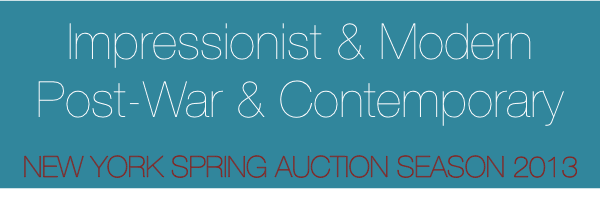 This report analyzes the results from the Impressionist & Modern and Post-War & Contemporary sales, 12 auctions from Sotheby’s, Christie’s and Phillips were analyzed, a total of $1,587,792,150 USD in art transactions.
This report analyzes the results from the Impressionist & Modern and Post-War & Contemporary sales, 12 auctions from Sotheby’s, Christie’s and Phillips were analyzed, a total of $1,587,792,150 USD in art transactions.
Download PDF
London Auction Season – February 2013
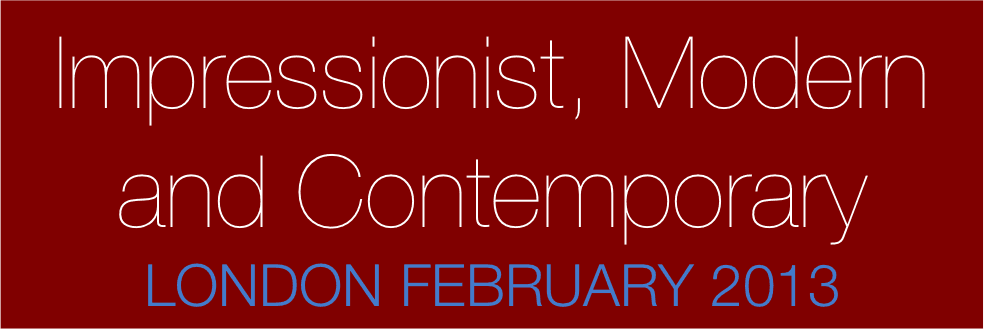 The purpose of this study is to give a very broad idea of the current state of two particular art markets: Impressionist and Modern Art, Post-War and Contemporary Art .
The purpose of this study is to give a very broad idea of the current state of two particular art markets: Impressionist and Modern Art, Post-War and Contemporary Art .
Download PDF
Old Master Week Auction Analysis: New York – January 2013
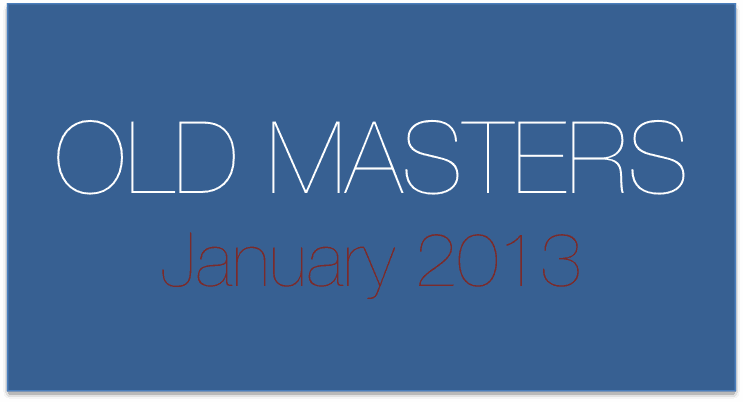 The following report analyzes the Old Master sales in New York. Although the general outcome was not bad, the results reflect a low market where high quality artworks are very scarce. The objective of this analysis is to study the current state of the Old Master’s Market by calculating statistical variables like: average prices, bought-in rates, price distributions, top lots, etc.
The following report analyzes the Old Master sales in New York. Although the general outcome was not bad, the results reflect a low market where high quality artworks are very scarce. The objective of this analysis is to study the current state of the Old Master’s Market by calculating statistical variables like: average prices, bought-in rates, price distributions, top lots, etc.
Download PDF
New York Auction Season Analysis – November 2012
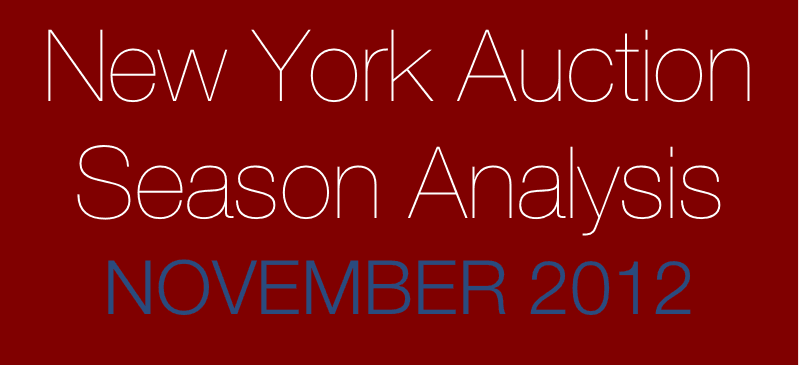 The purpose of this study is to give a very broad idea of the current state of three particular art markets: Impressionist and Modern Art, Post-War and Contemporary Art and Latin-American Art. The total of the auctions studied account for $1,494,210,000 USD in sales and 2,293 lots offered.
The purpose of this study is to give a very broad idea of the current state of three particular art markets: Impressionist and Modern Art, Post-War and Contemporary Art and Latin-American Art. The total of the auctions studied account for $1,494,210,000 USD in sales and 2,293 lots offered.
Download PDF
Contemporary Art Auction Analysis: London and Hong Kong – October 2012
 This analysis aims to study the current state of the Contemporary Art Market by calculating statistical variables like: average prices, bought-in rates, price distributions, top lots, etc. The results analyzed are from the Contemporary Art auctions in London and Hong Kong.
This analysis aims to study the current state of the Contemporary Art Market by calculating statistical variables like: average prices, bought-in rates, price distributions, top lots, etc. The results analyzed are from the Contemporary Art auctions in London and Hong Kong.
Download PDF
London Auction Season – June 2012

Brief analysis from the Impressionist, Modern, Post-War and Contemporary Art auctions in London. Information about the record prices, top lots sold and price distributions.
Download PDF
New York Auction Season – May 2012

Brief analysis from the Impressionist, Modern, Post-War, Contemporary and Latin American Art auctions in New York and Mexico City. Market insight, top lots sold, general results and price distributions.
Download PDF
Why is Art an Alternative Investment Asset?

Interesting current Art-Market facts and information about Artemundi Global Fund’s reasons to consider art an investment asset.
Download PDF
Price Distributions in the Art Market
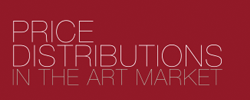
This analysis aims to find the price range were most art transactions take place; in order to do this, price distributions from approximately 5,000 artworks sold at auctions were built.
Download PDF
FAQ

Frequently asked questions about the art market and art as an alternative investment.
Download PDF
We recommend the following art-market analysis sites because of their serious approach to the industry. Not only have they become the information support for art-investment vehicles but they have also lead investors and collectors with confidence and assurance.
